
Ready to modernize your purchasing process and reduce your AP workload through automation? Let’s dive in.
Fill out the form to get your free eBook.

If you’ve outgrown your purchasing process you probably notice unnecessary delays, friction, and clunky approvals. Not only does it hold back your daily purchasing efforts, but it creates more work overall for AP. By streamlining your purchasing process you can overcome the messy approvals, bottlenecks, and limited visibility that come with an outdated process. It also means AP can say goodbye to surprise invoices and late payments. Download the eBook and discover:
- How to recognize the signs you’ve outgrown your purchasing process
- How to design a modern purchasing process that allows AP to get involved earlier in purchasing decisions
- How to launch this process quickly and seamlessly
What is a Purchase Order?
A purchase order (PO) is a legal document form used by a buyer and sent to a supplier for an order. It specifies items, quantities, prices, and credit terms for a purchase from the vendor. A PO becomes a legally binding contract when a vendor accepts it.
POs create a formal record of a buyer’s intent to purchase, supporting procurement compliance. A purchase order from the buyer initiates an order from a supplier, whereas an invoice is used to pay for received goods or services.
Purchase Order Form Example
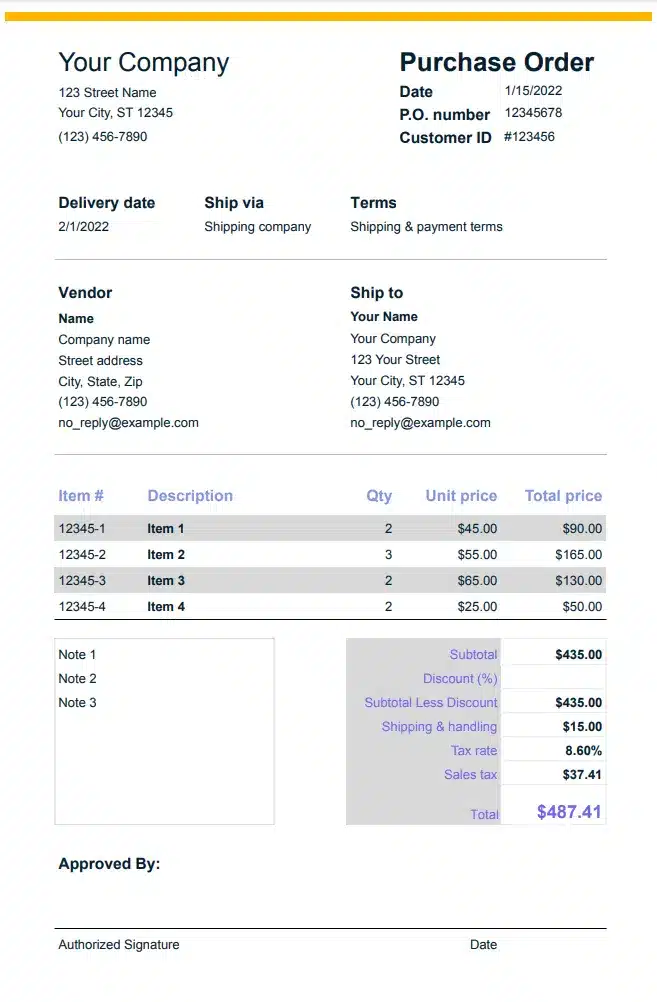
Why Purchase Orders Are the Backbone of Smarter Spending
A buyer’s purchase order is primarily used to initiate a business order for specific goods or services with a vendor. An approved purchase order states the agreed terms and offers legal protection for both the customer and the vendor selling the ordered items.
Purchase order items, quantity, and prices (and receiving information) are matched with an invoice by the customer to ensure that the items have been ordered and billing is correct before paying the vendor.
Purchase orders are sequentially numbered and provide an audit trail in the system.
Why Every Business Needs Purchase Orders
Issuing a purchase order results in better approval processes, spend management, and internal control over purchases. Purchase orders are numerically controlled for internal control with a sequential PO number on each form.
The Benefits of Purchase Orders
Using purchase orders with binding contract terms can prevent or help resolve payment disputes between actual sellers and purchasers. Businesses try to keep these customer disputes private unless they involve publicly disclosed litigation cases.
Without a legitimate purchase order, businesses may inadvertently pay fake invoices. PO matching can detect and prevent fraud in online payments.
The most cited case study for fake invoices paid without receiving purchase orders is the 2019 Google and Facebook incident (reported by CNBC). The companies respectively paid $23 million and $100 million in fake invoices when being scammed by a Lithuanian cybercriminal.
The money paid in invoice fraud is generally not recoverable, although Google and Facebook recovered their funds initially lost in this example of payment fraud.
How Does a Purchase Order Work?
The purchasing process begins with an approved purchase requisition and vendor bids, followed by the creation of purchase orders (POs).
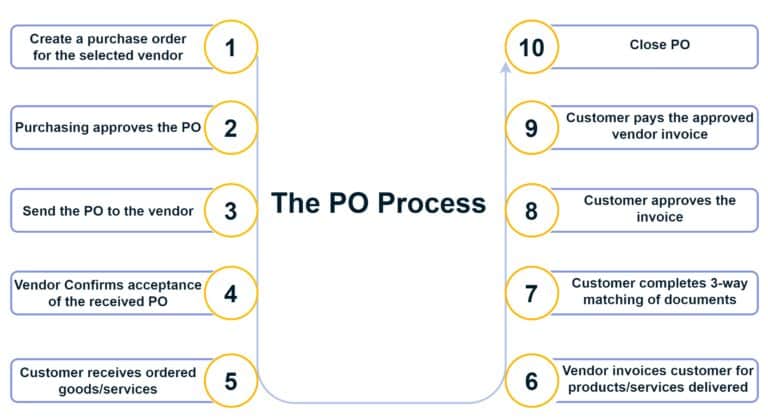
Steps in the Purchase Order Process:
• Create a purchase order for the selected vendor
• Purchasing approves the PO
• Send the PO to the vendor
• Vendor confirms acceptance of the received PO
• Customer receives ordered goods or services
• Vendor invoices the customer for products shipped or services delivered
• Customer completes 3-way matching of documents
• Customer approves the invoice
• Customer pays the approved vendor invoice
• Close PO
1. Create a purchase order for the selected vendor
After selecting a vendor and agreeing on terms, the purchasing department completes the purchase order form, preferably electronically, using an ERP system with a procurement module’s PO system and integrated Procurement automation software for more efficiency.
2. Purchasing approves the PO
Within the purchasing or procurement department, an authorized approver signs the purchase order. The approver will confirm that an approved purchase requisition exists if one is required. In some cases, to support large orders, a more detailed, formal legal contract is also created and signed by the parties.
3. Send the PO to the vendor
The customer’s purchasing department sends the purchase order to the vendor.
4. Vendor confirms acceptance of the approved PO
The vendor or supplier accepts the purchase order, sends the customer a purchase order confirmation, and begins fulfilling its terms by possibly ordering parts or products and manufacturing goods not currently in stock per its inventory management system, then delivering products or services to the customer.
A purchase order confirmation means that a supplier and its customer have agreed-upon terms, pricing, and delivery dates for an order. The purchase order form is a legally binding agreement at this point.
5. Customer receives ordered goods or services
The customer receives all goods or services ordered through the purchase order (or a partial shipment if items are backlogged).
6. Vendor invoices the customer for products shipped or services delivered
Once the product is shipped, or the services are delivered, the supplier invoices the customer for payment, using the invoice number, customer account number, and purchase order number as identifying numbers on the invoice. The customer records invoice amounts as accounts payable and inventory, fixed assets, or expenses.
The vendor may use a PO flip to automate and create an invoice from digital PO information in the procurement system.
7. Customer completes three-way matching of documents
When the goods are received, the customer matches the vendor invoice with supporting documents like the purchase order and receiving report or vendor packing slip for adequate internal control. The accounts payable process also includes checking invoices for mathematical accuracy.
8. Customer approves the invoice
Authorized approvers view the matched supporting documents and approve the invoices for payment.
9. Customer pays the approved vendor invoice
When it’s time to collect an early payment discount or when the invoice is due (according to purchase order terms), the customer pays the vendor invoice for goods or services received and reduces accounts payable in the accounting software by applying the payment to the applicable vendor invoice.
10. Close the PO
When all goods and services listed in the PO have been received for this order the customer has been invoiced, and the invoice has been paid, the customer’s purchasing department closes the PO.
Your business needs a smarter, AI-powered purchase order process.
Procurement automation software makes intake-to-procure easier and more efficient for creating and approving purchase requisitions and purchase orders.
Different Types of Purchase Orders
Different types of purchase orders include:
- Standard purchase orders (PO)
- Planned purchase orders (PPO)
- Blanket purchase orders (BPO)
- Contract purchase orders (CPO), and
- Digital purchase orders (DPO).
A description of these types of purchase orders follows.
Standard Purchase Orders (PO)
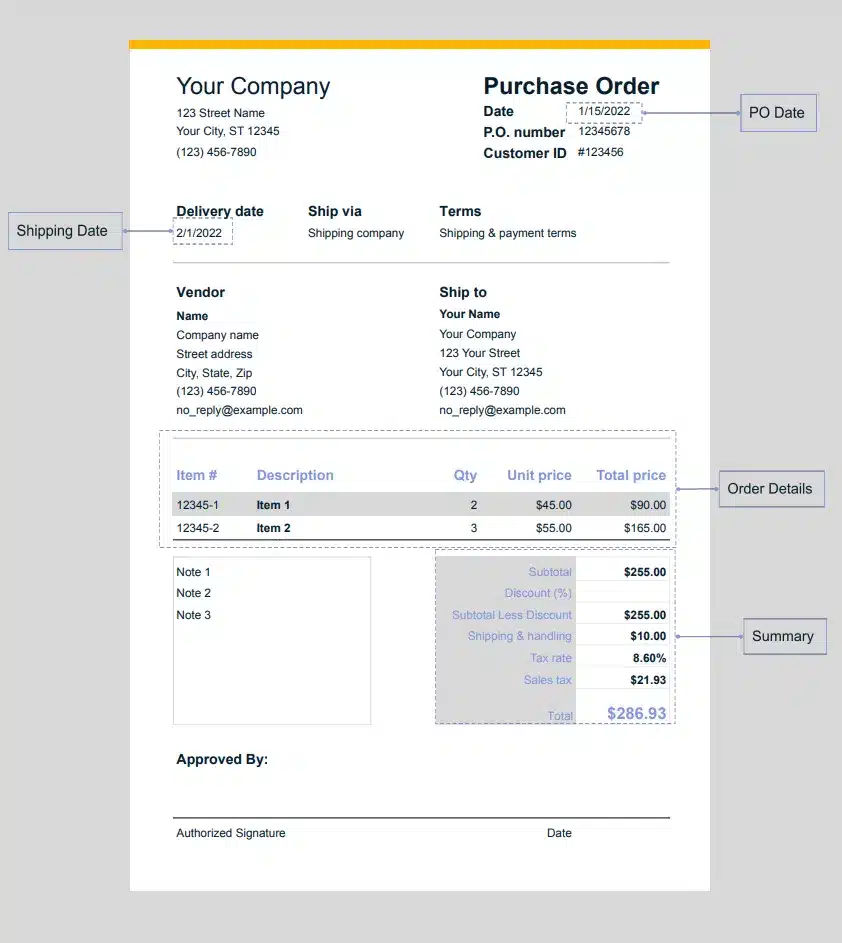
Standard purchase orders (POs) are used for most one-time, immediately released purchases. They include all relevant purchase order details, such as product or service descriptions, pricing, quantity, delivery date, and payment terms.
Once approved, a standard PO becomes a legally binding agreement between buyer and vendor for a specific transaction.
Planned Purchase Orders (PPO)
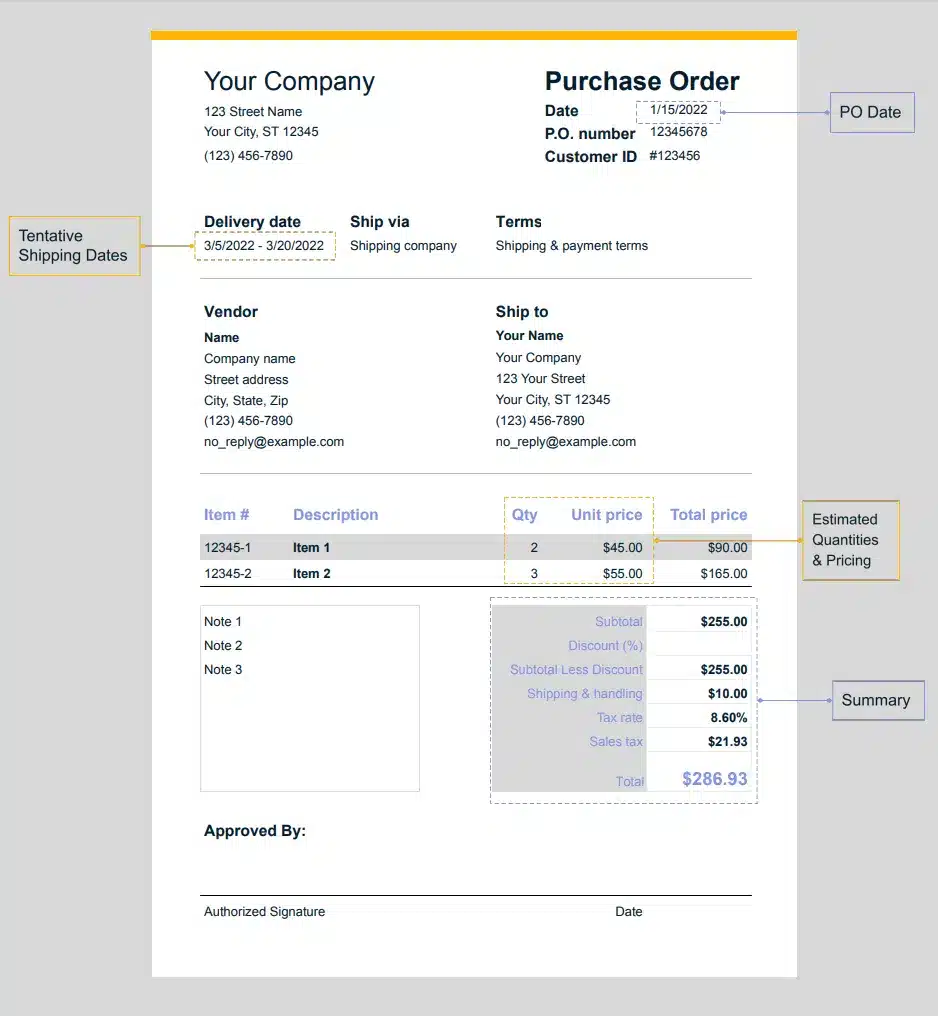
Planned purchase orders (PPOs) are long-term purchase agreements with a commitment to buy goods or services from a specific vendor over time. These orders typically include estimated quantities, pricing, billing account information, and tentative delivery schedules.
However, unlike standard POs, planned POs do not specify exact delivery dates or quantities upfront. Instead, scheduled releases are issued against the planned purchase order to initiate actual orders.
This provides more flexibility in terms of delivery timing and volume, making PPOs ideal for businesses that expect recurring needs but want to retain agility in fulfillment.
Blanket Purchase Orders (BPO)
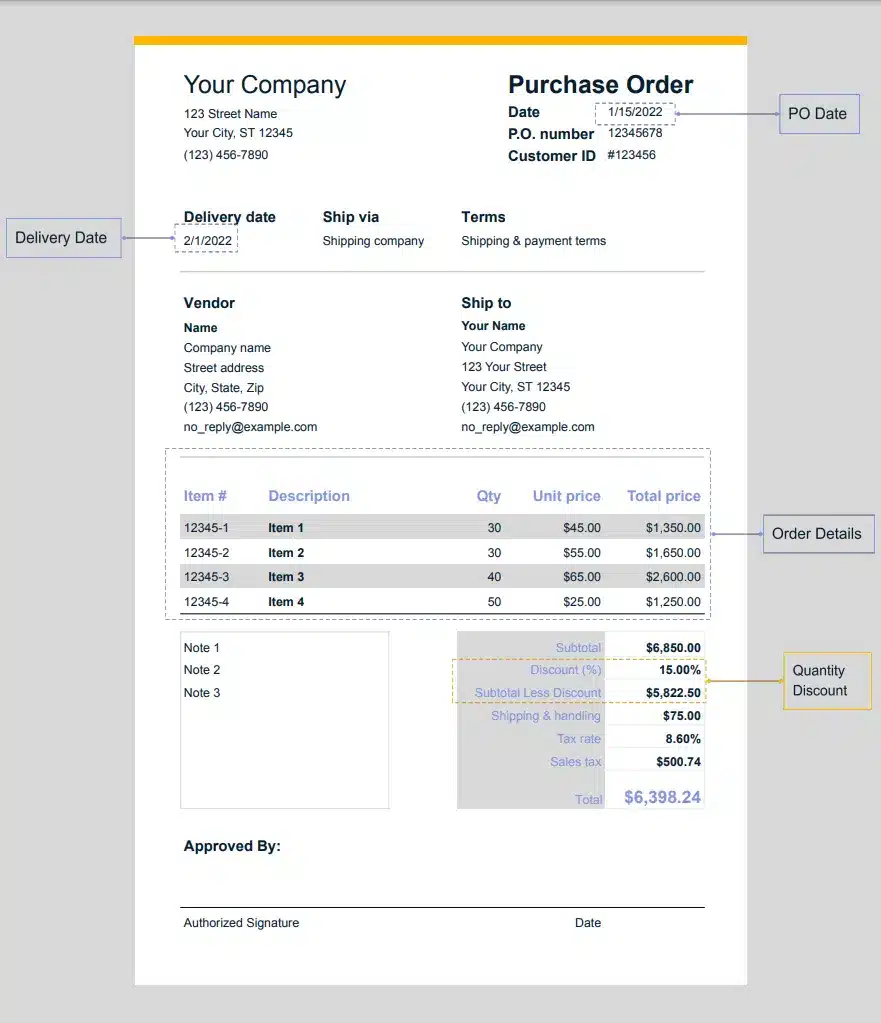
A blanket purchase order (BPO) is a customer order that covers an entire contractual order with deliveries made by the vendor over a period of time. When needed, the customer requests or schedules deliveries for recurring purchases included in the blanket PO total.
One benefit of blanket purchase orders is receiving quantity discount pricing in return for the commitment. Standard POs are then issued against the blanket PO as specific needs arise.
These POs reference the BPO and include the actual quantity, delivery dates, and any other finalized details. This structure helps consolidate purchasing efforts while maintaining contract pricing and terms.
Contract Purchase Orders (CPO)
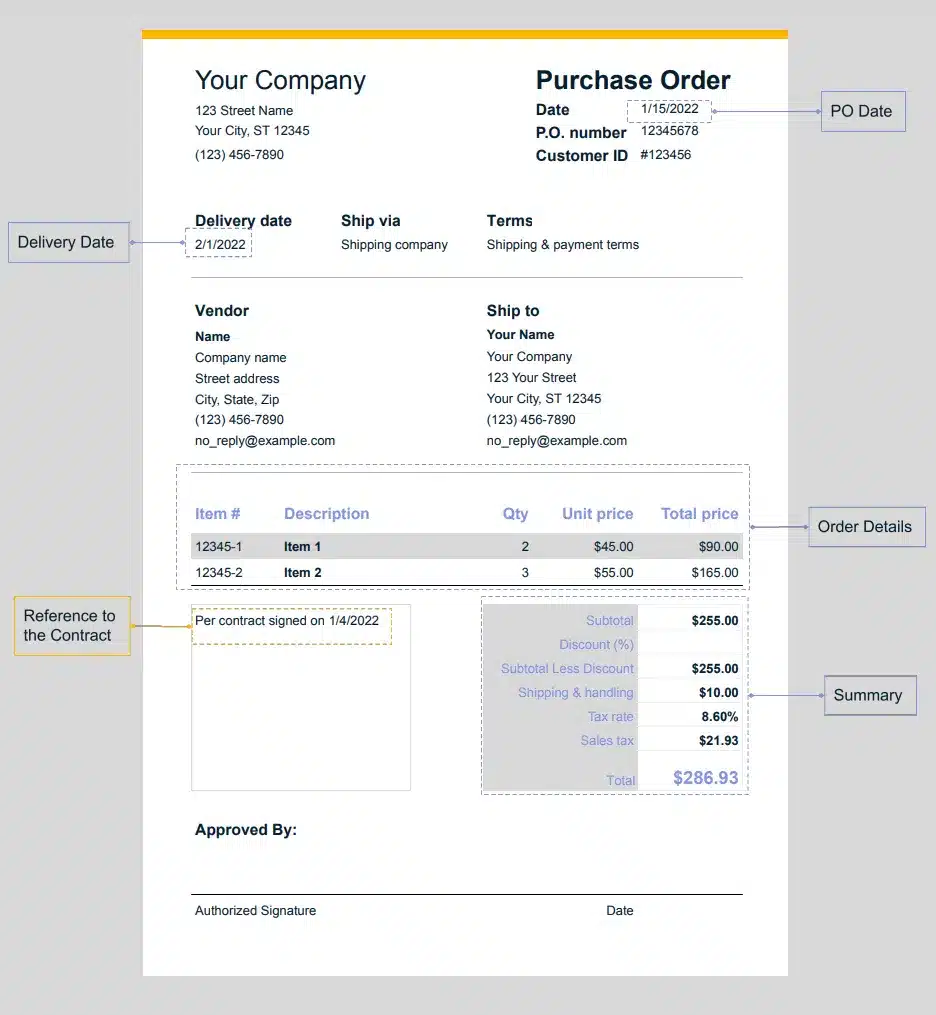
Contract purchase orders (CPO)—also known as contract purchase agreements—are framework agreements that define the legal and commercial terms between buyer and supplier.
Unlike other PO types, CPOs do not include specific item details or delivery schedules. Instead, standard purchase orders are later issued under the contract, referencing the agreed-upon terms and conditions. This is ideal for organizations that want to negotiate terms in advance but finalize purchases as needed over time.
Digital Purchase Orders (DPO)
Digital purchase orders (DPO) are electronic purchase orders created through an automated PO system as part of the PO process.
Digital purchase orders (DPO) are electronically generated and managed through e-procurement systems. They eliminate the need for paper-based processes, enabling automation, real-time tracking, and integration with ERP or procurement automation platforms like Tipalti.
Digital POs improve accuracy, reduce manual work, and streamline the entire procure-to-pay process—from requisition to PO issuance, approval, and invoice matching.
How to Create a Purchase Order
A purchase order, prepared by the procurement team, is usually supported by an approved purchase requisition to purchase goods or services.
Creating a purchase order is mostly a matter of collecting information to fill out the purchase order form.
The purchase order includes billing and contact information, shipping address and other shipping information, delivery date, payment terms, line items with description, part number, quantity, pricing, and totals.
Purchase order details include:
- PO number (purchase order number)
- Date of the purchase order and delivery
- Customer and vendor company name and contact information
- Billing address
- Shipping address
- Legal and payment terms
- Line items including:
- Product or service descriptions
- Product numbers or SKUs for retail and eCommerce businesses
- Pricing
- Quantity
- Extended amount
- Subtotal
- Any sales tax due for non-resale items
- Invoice Total
The product numbers or SKUs help businesses achieve inventory management related to the order.
Note: For a more detailed, step-by-step walkthrough of creating POs, explore our article on the purchase order creation process.
Purchase Order Template Resources
If your business doesn’t have software capable of creating a purchase order, consider using a Microsoft Excel purchase order template or Google Forms purchase order template. You can also consider using special-purpose software apps that integrate with your accounting software to create purchase order forms.
Automating Purchase Order Creation
Businesses use four system functions when automating purchase order creation:
- ERP-Based Purchase Order Tools
- AI-Powered Procurement Automation
- Supplier Communication Methods
- Supplier Portals and Document Centralization
ERP-Based Purchase Order Tools
Many ERP systems include purchase order systems integrated with the accounting and accounts payable system. Businesses can create an electronic purchase order (digital PO) using their e-procurement software.
Some ERP and Procurement automation systems include a purchase requisition to complete using the software, submitting it for approvals, and notifying Procurement through the system. It may be possible to automatically create an electronic purchase order from a digital purchase requisition in the system.
A purchase requisition is a form filled out by an employee requesting a purchase of goods or services. It’s approved or declined by an authorized manager with budgetary control responsibilities in the requester’s functional area. Company policy/procedure dictates whether a second approval signature is required at a higher level of authority if the purchase requisition exceeds a defined amount.
AI-Powered Procurement Automation
The best solution is to add third-party AI-powered Procurement automation software that integrates with your ERP system or accounting software as an intake-to-procure solution. It includes submitting and approving purchase requisitions, efficiently creating POs from purchase requisitions, and approving electronic purchase orders (Tipalti Procurement).
Pro Tip: Procurement automation streamlines procurement workflows with best practices. It gives stakeholders real-time visibility.
Supplier Communication Methods
Customers choose to email or text purchase orders or submit them to suppliers through a supplier portal. (Automated systems may still offer an inefficient choice of printing and mailing purchase orders to vendors in a company’s supply chain.) Collaborative supplier communication functionality between approvers and suppliers is one of the new features of Tipalti Procurement’s intake-to-procure automation software.
Pro Tip: Easy supplier communications for approvers increase purchasing speed and improve procurement decisions.
Supplier Portals and Document Centralization
Some customers use an online supplier portal. The portal integrates with their ERP management software and third-party add-on AP automation software. It’s accessible to both the customer and its suppliers. Combining these tools will streamline workflows, eliminate manual tasks, prevent lost paperwork, save time, and minimize disruptions experienced by the accounts payable team.
Purchase orders and related documents like contracts, vendor W-9 or W-8 tax forms, and vendor invoices can be submitted and stored centrally through the supplier portal. System communication capabilities include status and delivery inquiries or notifications through the portal.
Statistics for Procurement Automation Benefits
Procurement Magazine cites Keelvar’s study results relating to the usage and benefits of AI procurement automation in its January 7, 2025, article. Keelvar specializes in sourcing automation in procurement. Quotes from the Keelvar survey follow:
The report highlights that 52% of procurement teams have adopted automation technologies, significantly improving speed, efficiency and responsiveness, whilst those yet to act face growing challenges to remain competitive.
Keelvar’s report highlights the advantages realised by procurement teams adopting automation:
- 60% reduced time spent on repetitive tasks
- 56% decreased risk of errors
- 40% improved responsiveness to market changes
- 35% freed up resources for strategic initiatives
Tipalti Procurement automation software is AI-driven. It helps users in similar ways and is vital for businesses to remain competitive and responsive to the need to quickly adapt their supply chain in a period of rapidly changing tariffs.
FAQs
The following FAQs list and answer frequently asked questions about purchase orders.
What is the Difference Between a Purchase Requisition and a Purchase Order?
The difference between a purchase requisition vs purchase order is that a purchase requisition may be considered a purchase order request.
A purchase requisition is a form completed by an employee to gain management approval for purchasing goods or services from a vendor with a purchase order issued by the purchasing department.
What is a Purchase Order vs Invoice?
A purchase order vs invoice is the difference between a customer placing an order to buy goods or services with a vendor using a purchase order form vs a vendor issuing a bill upon shipment, requesting payment.
Purchase orders and invoices have corresponding line item information, including product description, product number, quantity shipped, totals, and payment terms.
What Does PO Flip Mean?
A PO flip (purchase order flip) automatically converts a purchase order into an invoice and submits the invoice to the accounts payable department of the buying company making the purchase. E-procurement software creates an electronic invoice from digital purchase order information.
What Does Purchase Order Financing Mean?
Purchase order financing (PO finance) means that customers can use their purchase orders to obtain the cash needed to pay suppliers before inventory is sold to its customers and it collects accounts receivable from the sales.
Is a Purchase Order Considered a Legally-Binding Contract?
A purchase order is a legal document that’s a binding contract between the customer and supplier upon vendor acceptance. A purchase order establishes delivery, billing, specific products or services ordered, legal, and payment terms.
Preparing for the Future of Purchase Order Management
In a world rapidly shifting toward automation, relying on manual, paper-based procurement processes is no longer sustainable. Purchase orders are no longer just paperwork—they’re a strategic lever for control, efficiency, and fraud prevention.
Modern finance teams are embracing AI-driven tools to automate procurement from intake to pay, eliminating bottlenecks and boosting visibility. If your PO process still slows you down, now’s the time to evolve.
Don’t get left behind. Download our free Ebook to discover how leading companies are transforming purchase order workflows to scale smarter and stay competitive.
